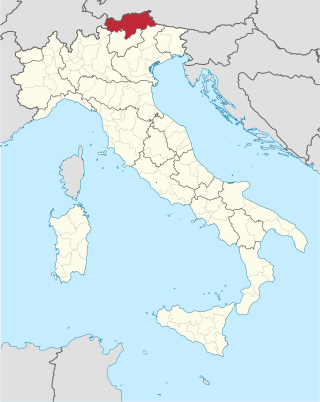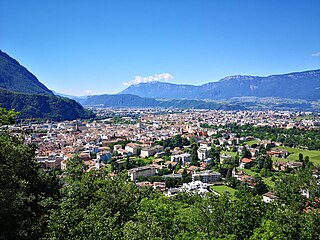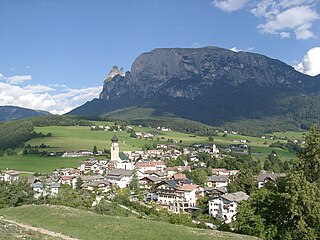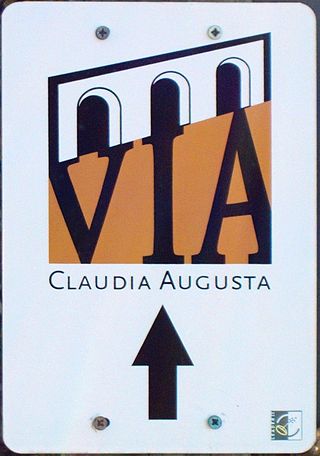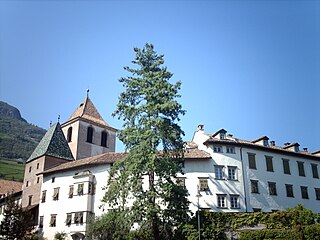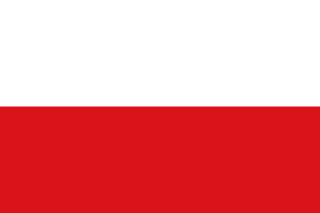This article needs additional citations for verification .(February 2024) |
This is a list of castles in South Tyrol in Italy.
- Castle Aichberg, Eppan an der Weinstraße
- Altenburg bei St. Pauls, Eppan an der Weinstraße
- Annaberg, Goldrain
- Castle Auer, Tirol
- Castleruine Boymont, Eppan an der Weinstraße
- Castle Bruneck, Bruneck
- Brunnenburg, Tirol
- Churburg, Schluderns [1]
- Castle Enn, Montan
- Castle Ehrenburg, Kiens
- Castleruine Eschenloch, Ulten
- Fahlburg, Tisens-Prissian
- Castle Festenstein
- Fingellerschlössl/Walbenstein, Sarntal
- Fischburg, in Sëlva
- Castle Freudenstein, Eppan an der Weinstraße
- Fürstenburg, Mals
- Castle Gandegg, Eppan an der Weinstraße
- Castleruine Goien, Schenna
- Castle Goldrain, Goldrain [2]
- Castle Gravetsch, Villanders
- Castle Greifenstein, Terlan, (aka. Sauschloss (Pig Castle))
- Haderburg, Salorno
- Haselburg, Bolzano
- Castle Hauenstein, Seis am Schlern [3]
- Castle Hocheppan, Eppan an der Weinstraße
- Johanneskofel, Sarntal
- Castel Juval, Naturns
- Castleruine Kaldiff, Neumarkt
- Castle Karneid, Karneid
- Castle Kasatsch, Nals, (aka. Castle Pfefferberg)
- Castle Kastelbell, Kastelbell-Tschars
- Castle Katzenzungen, Tisens-Prissian
- Castle Klebenstein, Bolzano
- Castle Laimburg, Vadena
- Castle Lamprechtsburg, Bruneck
- Landesfürstliche Burg, Meran
- Leuchtenburg, Italy, Vadena
- Castle Lichtenberg, Prad am Stilfserjoch
- Castle Lebenberg, Tscherms
- Castle Maretsch, Bolzano
- Marienberg, Mals (a former castle, now an abbey)
- Castle Matschatsch, Eppan an der Weinstraße
- Michelsburg, St. Lorenzen
- Castle Moos, Eppan an der Weinstraße
- Mühlbacher Klause, Mühlbach
- Castle Neuhaus, Gais
- Castle Neuhaus, Terlan (aka. Castle Maultasch]
- Castle Niemandsfreund, Kastelruth
- Schloss Nussegg, Kurtatsch
- Castle Obermontani, Morter
- Castle Payrsberg, Nals
- Castle Pienzenau, Meran
- Prösels Castle, Völs am Schlern
- Castleruine Rafenstein, Bolzano
- Castle Reichenberg, Taufers im Münstertal
- Castle Reifenegg, Ratschings
- Reifenstein Castle, Sterzing
- Castle Ried, Ritten
- Castle Rodenegg, Rodeneck
- Rotund, Taufers im Münstertal
- Runkelstein Castle, Bolzano
- Monastery Säben, earlier Castle Säben, Klausen
- Castle Salegg, Seis am Schlern [4]
- Castle Schenna, Schenna
- Schlandersburg, Schlanders
- Castle Schöneck, Kiens
- Castle Schwanburg, Nals
- Sigmundskron Castle, a big fortress, Bolzano
- Monastery Sonnenburg, earlier Castle Sonnenburg, St. Lorenzen
- Castle Sprechenstein, Freienfeld/Sterzing
- Castleruine Stein am Ritten, Ritten
- Castle Stetteneck, Urtijëi
- Castle Strassberg, Sterzing
- Castle Summersberg, Gufidaun
- Castle Tarantsberg
- Castle Taufers, Sand in Taufers
- Tirol Castle, Tirol
- Castle Thurn, San Martin de Tor
- Castle Thurnstein, Tirol
- Trauttmansdorff Castle, Meran
- Treuenstein Castle, Bozen/Bolzano
- Trostburg, Waidbruck
- Tschenglsburg, Tschengls
- Unterkofeler Schlössl, Afing
- Castle Untermontani, Morter
- Castle Velthurns, Felthurns [5]
- Castle Wangen-Bellermont, Ritten
- Castle Warth, Eppan an der Weinstraße
- Wehrburg, Tisens
- Castle Weineck, Bolzano
- Castle Welsperg, Welsberg
- Castle Wolfsthurn, Mareit [6]
- Castle Wolkenstein, Sëlva
- Zenoburg, Meran
- Castle Zwingenburg, Tisens
